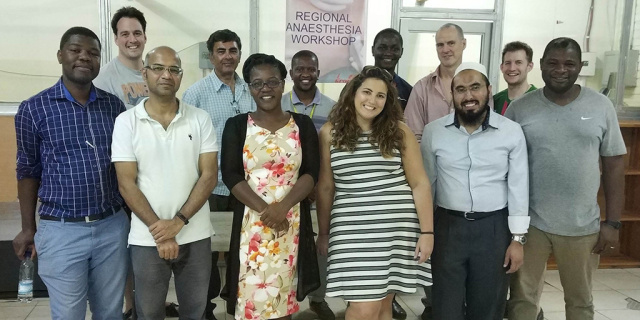
Consultant and trainee anesthetists from Surrey, England traveled to Lusaka, Zambia with a point-of-care ultrasound (POCUS) system to train Zambian colleagues in ultrasound-guided regional anesthesia. Dr. Madankumar Narayanan describes the educational objectives of the visit and the enthusiastic response from doctors in Zambia, as the team demonstrated the benefits of ultrasound-guided interventions in classroom workshops and on patients.
Responding to a Need in Zambia
Anesthetic trainees in the UK often undertake an "out-of-program" fellowship to developing countries to expand their clinical and professional experiences. One such trainee visited the University Teaching Hospital in Lusaka for his fellowship and saw the challenges of managing patients’ pain without the use of ultrasound-guided nerve blocks. On his return, he decided to rally the support of his UK colleagues and arrange a training visit to show Zambian anesthetists how using ultrasound for vascular access and administering nerve blocks. Three consultants and one trainee were able to commit to this project and linked up with two British trainees already in Zambia.
Well-Equipped to Introduce Ultrasound
The University Teaching Hospital in Lusaka is the largest, most advanced hospital in Zambia and was a logical starting place for the training initiative. A seven day visit was planned – two days of classroom teaching, four days practical training in theatre, and a day of consolidation. The UK team was equipped with a portable FUJIFILM Sonosite point-of-care ultrasound machine, donated for the training exercise and for the hospital in Lusaka for future use.
Anesthetists at the University Teaching Hospital in Lusaka were unfamiliar with POCUS. Their process for choosing vascular access sites was based purely on clinical landmarks, and they had used very little ultrasound in their diagnostic evaluations or management of pain. Most of the theatre anaesthetists had never even seen nerve blocks performed. There is also limited availability of pain-relief medication in Zambia. Post-operative patients were having to tolerate significant levels of pain, which often increased their length of stay in hospital.
Delivering Training
The UK team carried out a preliminary workshop for 20 anesthetists from across Zambia, with comprehensive reading material provided beforehand. The workshop concentrated on demonstrations of how to use the machine, how to hold the needles, how to scan, and most importantly, how to guide vascular access and identify individual nerves. Four theatre anesthetists from the workshop were selected, and they were provided with hands-on training on patients in their theatres. This training initially focused on simple, low-risk nerve blocks – femoral, fascia iliac, axillary, and popliteal – to help them improve their confidence.
Response of Zambian Doctors
The beauty of the Sonosite ultrasound machines is that they are extremely intuitive to clinicians who have never used POCUS before. The systems can withstand plenty of use and occasional unintended knocks or drops, and are incredibly user-friendly, which encourages continued learning and use of the machine. The presets are also very helpful and crucially, within a few minutes, the Zambian anesthetists could correlate what they could see under ultrasound with what they already knew about anatomy. Their understanding of anatomy helped them progress to use ultrasound to guide their identification of nerves and veins. After just two days of training, the local anesthetists were very excited about developing the use of POCUS for the management of pain, particularly for patients following limb trauma surgery. They could immediately see huge potential for its use across Zambia, and plans are already in place for the four anesthetists trained in theatre to teach others within the hospital.
The Lusaka project has been successful in increasing awareness of POCUS for pain management across Zambia. The Zambian anesthetists are enthusiastic to develop their skills further. The UK team is eager to continue supporting hospitals in Lusaka and across the country, and to ultimately improve the lives of Zambians living with pain.

